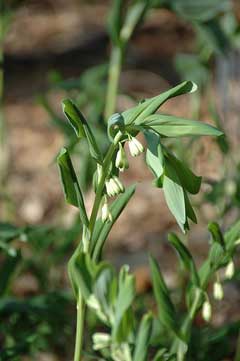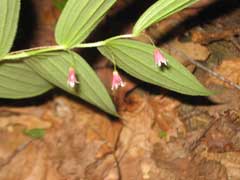 |
|
www.flickr.com/photos/flatbushgardener |
 |
| http://commons.wikimedia.org/wiki/User:Jomegat |
Translate this page:
Summary
Physical Characteristics

 Polygonatum biflorum is a PERENNIAL growing to 1 m (3ft 3in).
Polygonatum biflorum is a PERENNIAL growing to 1 m (3ft 3in).
See above for USDA hardiness. It is hardy to UK zone 3. It is in flower in May. The species is hermaphrodite (has both male and female organs) and is pollinated by Bees. The plant is self-fertile.
Suitable for: light (sandy), medium (loamy) and heavy (clay) soils and prefers well-drained soil. Suitable pH: mildly acid, neutral and basic (mildly alkaline) soils. It can grow in full shade (deep woodland) or semi-shade (light woodland). It prefers moist soil.
UK Hardiness Map
US Hardiness Map
Synonyms
Plant Habitats
Woodland Garden Dappled Shade; Shady Edge; not Deep Shade;
Edible Uses
Edible Parts: Leaves Root Shoots
Edible Uses:
Young shoots - raw or cooked[159, 177]. An excellent vegetable when boiled and used as an asparagus substitute[183]. Root - cooked[61]. The flavour is somewhat bitter, to counteract this the root is sliced crosswise, cooked in alkaline water and the water changed during the cooking process[183]. When steamed and sun-dried nine times the root is delicious[179]. The roots are rich in starch, this can be extracted by beating or grinding the dried root, the starch can then be used to make bread or can be mixed in other foods such as soups[159, 183, 257].
References More on Edible Uses
Medicinal Uses
Plants For A Future can not take any responsibility for any adverse effects from the use of plants. Always seek advice from a professional before using a plant medicinally.
Laxative Poultice Sedative
A tea made from the roots is laxative[222]. It has been used in the treatment of indigestion, profuse menstruation, lung ailments, general debility etc[222]. It is a folk remedy for piles, rheumatism and skin irritations[222]. A poultice or a decoction of the fresh roots is applied to cuts, bruises, sores etc[222, 257].
References More on Medicinal Uses
The Bookshop: Edible Plant Books
Our Latest books on Perennial Plants For Food Forests and Permaculture Gardens in paperback or digital formats.

Edible Tropical Plants
Food Forest Plants for Hotter Conditions: 250+ Plants For Tropical Food Forests & Permaculture Gardens.
More

Edible Temperate Plants
Plants for Your Food Forest: 500 Plants for Temperate Food Forests & Permaculture Gardens.
More

More Books
PFAF have eight books available in paperback and digital formats. Browse the shop for more information.
Shop Now
Other Uses
Incense
The root has been burnt as an incense[257]. It is said that when the root is burnt in the bedroom just before going to sleep, the person would sleep soundly and awaken refreshed, rested and feeling young[257].
Special Uses
Food Forest
References More on Other Uses
Cultivation details
Prefers a fertile humus rich moisture-retentive well-drained soil in cool shade or semi-shade[200]. Plants are intolerant of heat and drought but they tolerate most other conditions[200]. A very ornamental plant, it grows well in woodland and copses[1, 42]. Members of this genus are rarely if ever troubled by browsing deer or rabbits[233]. The young shoots are very attractive to slugs[K]. Hybridizes with other members of this genus[200]. Polygonatum biflorum var. commutatum (Schult. & Schult.f.) Morong is a synonym of Polygonatum biflorum (Walter) Elliott The plant is heat tolerant in zones 9 through 1. (Plant Hardiness Zones show how well plants withstand cold winter temperatures.
Plant Heat Zones show when plants would start suffering from the heat.
The Plant Heat Zone map is based on the number of "heat days" experienced in a given area where the temperature climbs to over 86 degrees F (30°C).
At this temperature, many plants begin to suffer physiological damage. Heat Zones range from 1 (no heat days) to 12 (210 or more heat days).
For example Heat Zone. 11-1 indicates that the plant is heat tolerant in zones 11 through 1.) For polyculture design as well as the above-ground architecture (form - tree, shrub etc. and size shown above) information on the habit and root pattern is also useful and given here if available. The plant growth habit is a runner spreading indefinitely by rhizomes or stolons [1-2]. The root pattern is rhizomatous with underground stems sending roots and shoots along their length [1-2].
References Carbon Farming Information and Carbon Sequestration Information
Temperature Converter
Type a value in the Celsius field to convert the value to Fahrenheit:
Fahrenheit:
The PFAF Bookshop
Plants For A Future have a number of books available in paperback and digital form. Book titles include Edible Plants, Edible Perennials, Edible Trees,Edible Shrubs, Woodland Gardening, and Temperate Food Forest Plants. Our new book is Food Forest Plants For Hotter Conditions (Tropical and Sub-Tropical).
Shop Now
Plant Propagation
Seed - best sown as soon as it is ripe in early autumn in a shady part of a cold greenhouse[200]. Sow stored seed as early in the year as possible. Germination can be slow, they may not come true to type[200] and it takes a few years for them to reach a good size. When they are large enough to handle, prick the seedlings out into individual pots and grow them on in a shady position in the greenhouse for at least their first winter. Plant them out into their permanent positions in late spring or early summer, after the last expected frosts. Division in March or October. Larger divisions can be planted out direct into their permanent positions. We have found that it is better to pot up the smaller divisions and grow them on in light shade in a cold frame until they are well established before planting them out in late spring or early summer.
Other Names
If available other names are mentioned here
Native Range
NORTHERN AMERICA: Canada, Québec (southwest), Ontario (south), Saskatchewan (southeast), Manitoba (south), United States, Connecticut, Indiana, Michigan, New Jersey, Ohio, Pennsylvania, West Virginia, Illinois, Kansas, Minnesota, Missouri, Nebraska, North Dakota, Oklahoma, South Dakota, Wisconsin, Alabama, Arkansas, Delaware, Florida, Georgia, Kentucky, Louisiana, Maryland, Mississippi, North Carolina, South Carolina, Tennessee, Virginia, Texas,
Weed Potential
Right plant wrong place. We are currently updating this section.
Please note that a plant may be invasive in one area but may not in your area so it's worth checking.
Conservation Status
IUCN Red List of Threatened Plants Status :

Growth: S = slow M = medium F = fast. Soil: L = light (sandy) M = medium H = heavy (clay). pH: A = acid N = neutral B = basic (alkaline). Shade: F = full shade S = semi-shade N = no shade. Moisture: D = dry M = Moist We = wet Wa = water.
Now available:
Food Forest Plants for Mediterranean Conditions
350+ Perennial Plants For Mediterranean and Drier Food Forests and Permaculture Gardens.
[Paperback and eBook]
This is the third in Plants For A Future's series of plant guides for food forests tailored to
specific climate zones. Following volumes on temperate and tropical ecosystems, this book focuses
on species suited to Mediterranean conditions—regions with hot, dry summers and cool, wet winters,
often facing the added challenge of climate change.
Read More
Expert comment
Author
(Walter.)Elliott.
Botanical References
43200270
Links / References
For a list of references used on this page please go here
Readers comment
| Add a comment |
|
If you have important information about this plant that may help other users please add a comment or link below. Only comments or links that are felt to be directly relevant to a plant will be included. If you think a comment/link or information contained on this page is inaccurate or misleading we would welcome your feedback at [email protected]. If you have questions about a plant please use the Forum on this website as we do not have the resources to answer questions ourselves.
* Please note: the comments by website users are not necessarily those held by PFAF and may give misleading or inaccurate information.
To leave a comment please Register or login here All comments need to be approved so will not appear immediately.
|
Subject : Polygonatum biflorum
|
|
|
|